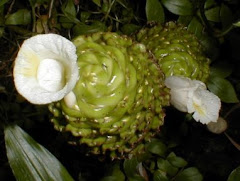REACTIONS
Allergic reactions to ginger generally result in a rash, and although it generally recognized as safe, ginger can cause heartburn, bloating, gas, belching and nausea, particularly if taken in powdered form. Unchewed fresh ginger may result in intestinal blockage, and individuals who have had ulcers, inflammatory bowel disease or blocked intestines may react badly to large quantities of fresh ginger.Ginger can also adversely affect individuals with gallstones. There are also suggestions that ginger may affect blood pressure, clotting, and heart rhythms.
Z.officinale products are made from fresh or dried ginger root, or from steam distillation of the oil in the root. The herb is available in extracts, tinctures, capsules, and oils. Fresh ginger root can also be purchased and prepared as a tea. Ginger is also a common cooking spice and can be found in a variety of foods and drinks, including ginger bread, ginger snaps, ginger sticks, and ginger ale.
RECIPES
1. Prevent Common Cold
Ingredient: An adequate amount of fresh ginger + brown sugar
Prescription: The fresh ginger & brown sugar are boiled and drunk to induce sweating after taking a nap under a thick blanket
Explaination: Prevent common cold. Brown sugar promotes blood circulation and ginger induces sweating by its hot nature.
2. Uncontrollable Coughing and Astma
Ingredient: Fresh ginger 30g + honey 500g
Prescription: Cut ginger into slices, then put them into honey & steam for 20min. After removing ginger, 30-50g of honey is orally administered, 1-2 times daily.
Explaination: Treat Uncontrollable Coughing and Astma caused by wind and dry pathogens.
3. Acute Heat pain
Ingredient: Large and ripe ginger 5g
Prescription: A decoction of chopped ginger taken.
Explaination: Treat onset of acute heart pain.
4. Hypotension
Ingredient: Clean fresh ginger with skin peeled.
Prescription: Chew 1g fresh ginger. It increases systolic blood pressure by 1.5kPa and diastolic pressure by 1.9kPa on average.
Explaination: Treat hypotension.
5. Cold and Pain in Stomach
Ingredient: An adequate amount of ripe ginger
Prescription: After drying & baking over low fire, ginger cut into small bits and taken with breakfast.
Explaination: Used to treat cold and pain in stomach.
6. Vomiting
Ingredient: Fresh ginger 20g
Prescription: Ginger pounded to prepare juice for oral consumption with warm water.
Explaination: Ginger expel cold pathogen to treat vomiting caused by accumulation of cold pathogen in stomach.
7. Hiccups
Ingredient: Fresh ginger 3g
Prescription: An attack of hiccups quickly controlled by drinking hot tea made with ginger bits.
Explaination: treat continuous hiccups due to an attack of cold in stomach or disorder of liver qi.
8. Cholera
Ingredient: Adequate amount of ginger slices + salt.
Prescription: a preparation of salt between 2 slices ginger used to rub chest with some water. Treatment continued for 15min. Then the part above sacrum rubbed for another 15min.
Explaination: Treat cholera with uncontrollable vomiting and diarrhea.
9. Abdominal pain and Muscle Spasm
Ingredient: Fresh ginger 90g.
Prescription: Pounded ginger boiled in 500ml wine. One oral administration.
Explaination: Treat uncontrollable diarrhea, abdominal pain and muscle spasm.
10. Malaria
Ingredient: Frsh ginger with skin 120g
Prescription: Ginger pounded to prepare juice. After storing overnight, cold ginger juice of 50ml taken before breakfast.
Explaination: Used to treat malaria due to retention of phlegm in spleen and stomach with repeated episodes of chills and fever.
11. Bone tuberculosis
Ingredient: Large amount of fresh or dried ginger
Prescription: Ginger paste is boiled in water for over an hour for a hot towel compress over lesion, twice a day.
Explaination: Produce warming effect to relieve stagnant blood and stop pain in tubersular bone before rupture of lesion.
12. Conjuctivitis
Ingredient: Adequate amount of fresh ginger
Prescription: Ginger slices applied around infected eye.
Explaination: Used to treat fire eye and red eye with infection, swelling,& pain due to other cause.
 CLASSIFICATION
CLASSIFICATION 

















































































